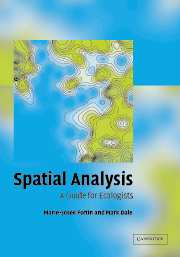Book contents
2 - Spatial analysis of population data
Published online by Cambridge University Press: 29 July 2009
Summary
Introduction
In this chapter, we describe methods for analysing completely censused ‘population’ data. Such data can be in one of two formats. The first we will discuss is the situation where there is a map of the locations of all ‘events’, such as individual organisms of a particular species, in an area, with or without accompanying information about each event, such as tree height or condition (see Figure 1.10a). This is a complete census for the entire extent of the study area, not a sample (although we will comment on the analysis of sample data in Chapter 3), and in most ecological examples the map is in two dimensions (with x−y coordinates), but we can consider one- or three-dimensional maps, as well (with only x or with x−y–z coordinates). The methods for analysing event location data can be based on determining the neighbours of each event and making calculations based on the distances to them, or may involve counting the events in circles of a given range of sizes, centred on the events or on randomly placed points. In studying the spatial structure of a one-species population of mature trees, the analysis is univariate. When two kinds of events are of interest, for example mature trees of a species and its seedlings, the analysis is bivariate. Multivariate analysis is applied when there are several kinds of events, as in a study of a multispecies forest community.
- Type
- Chapter
- Information
- Spatial AnalysisA Guide for Ecologists, pp. 32 - 110Publisher: Cambridge University PressPrint publication year: 2005
- 1
- Cited by



